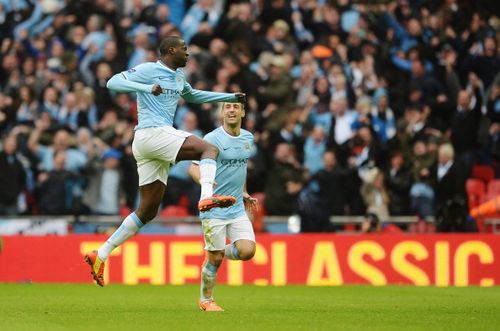
Manchester City 3-1 Sunderland: Tactical Analysis

Yaya Toure celebrates his wonder goal
A side going for a quadruple, and another looking to maintain it’s Premier League status. Only in the Capital One Cup will you see such contrasting seasons clash in the final. But this was the case when Manchester City took on Sunderland at Wembley.
Undoubtedly City were the favourites but Sunderland came with a sure game plan and stuck by it, going into half-time with the lead and momentum. But City were always going to be threatening. As images of the 2013 FA Cup Final flashed in the minds of the Man City players and fans, they came back storming in the second half, scoring 2 goals in under 2 minutes before getting a late third as well.
It was harsh on Sunderland, who did extremely well, but City were always going to be a threat going forward. Here’s what happened.
Line Ups

Manchester City: Pantilimon, Zabaleta, Kolarov, Kompany, Demichelis, Toure, Fernandinho, Nasri, Silva (Garcia 77?), Dzeko (Negredo 88?), Aguero (Navas 58?)
Sunderland: Manone, Bardsley, Alonso, Brown, O’Shea, Cattermole (Giaccherini 77?), Ki, Colback, Larsson (Fletcher 60?), Johnson (Gardner 60?), Borini
Sunderland’s gameplan
Quick direct passes, a side injected with pace, led by clinical finishers – that is City summed up in one sentence. Gus Poyet recognised the danger they posed if allowed to play their football and had to come up with a game plan that was both disciplined defensively, yet not restrictive in attack.
Thus, as expected, Sunderland sat back and invited pressure, but made sure they didn’t give too much space to the City players. The idea was to retrieve possession, either by an interception or a hopeful goal-kick as City weren’t allowed to penetrate the defensive line. Once they got possession, the ball was played out till the half-way line or cleared to a midfielder who usually found himself in space (namely Adam Johnson & Lee Cattermole), who would then play a long ball over the top aiming for the lone Italian, Fabio Borini. A simple approach, which was surprisingly effective for 45 odd minutes against the billions of Man City.
It was one such ball over the top that led to Borini’s early goal. Sunderland tried the above a couple of times before it eventually paid off, owing to a Kompany error. Full credit to Borini though who had quite a bit to do and didn’t disappoint, finishing with the outside of his boot.
That same gameplan was followed time and again, and City were repeatedly caught out. That long ball over the top was matched by advancing midfielders and full-backs, adding numbers to the Black Cats’ attack. But with a slender lead, a single plan was always going to be found out and the effectiveness of the simple approach reduced as the game wore on, culminating into total Man City domination.
All Man City needed was some space
Throughout the first-half, Man City failed to get past the Sunderland defence. For a side filled with stars, you’d expect them to perform much better in breaking a tidy defensive line. But besides one or two nifty balls over the defence, Manchester City had nothing. Set-pieces seemed to be their best avenue, something you’d expect their opponents to rely on.
Even as the second half got on, the story was the same. The urgency was there, but lack of ideas to get past the line of players. Then there was a moment around the 53rd minute. Free-kick in a good position, one of the best chances to get a meaningful shot on Vito Manone’s goal. But, shockingly, Nasri played a short pass to Toure and we were back to passes around the box and a defensive line from Sunderland. Didn’t quite get why Manchester City didn’t take the opportunity to just strike that, it wasn’t even a quick free kick.
But thankfully for Manchester City, shortly afterwards (in the same phase of play), Toure pulled one back with a brilliant long range effort. That goal rejuvenated City, and pulled Sunderland players out temporarily to add something in attack. It created space at the back for City to exploit, and a quick counter allowed Manchester City to take the lead, seconds after equalising. It was a matter of seconds in which Sunderland didn’t maintain their compactness, and the Citizens took full advantage, the first time in the game they were able to dictate terms with their type of football. All they needed was some space.